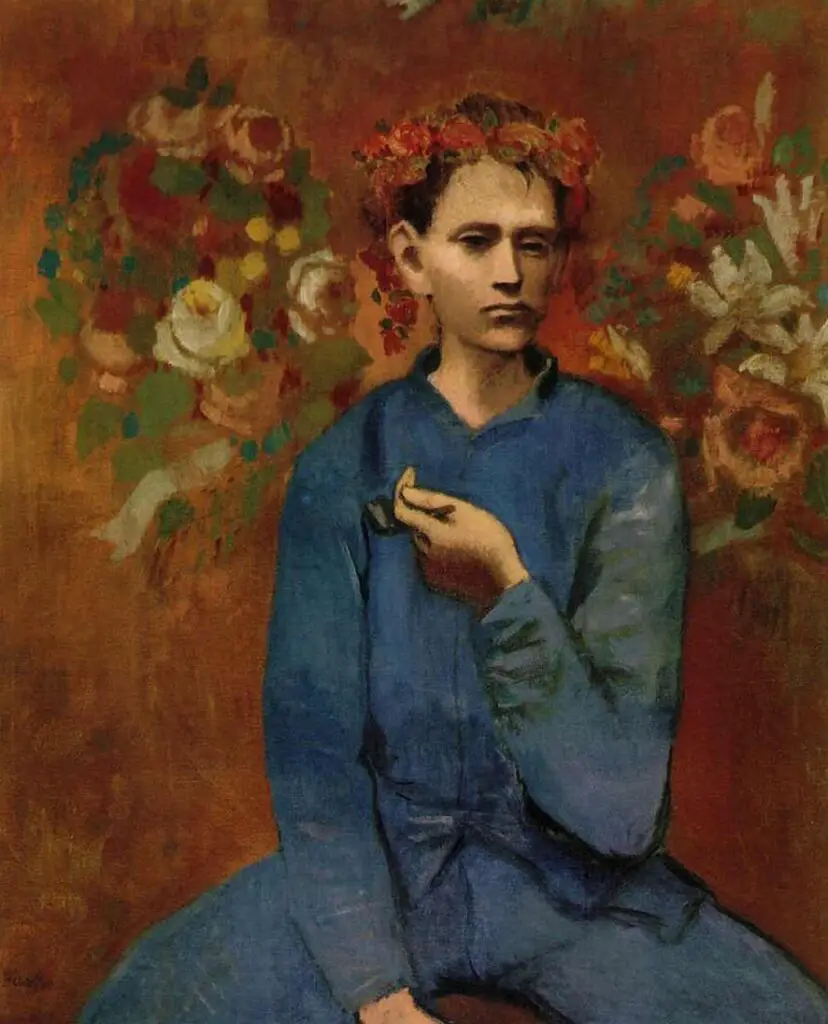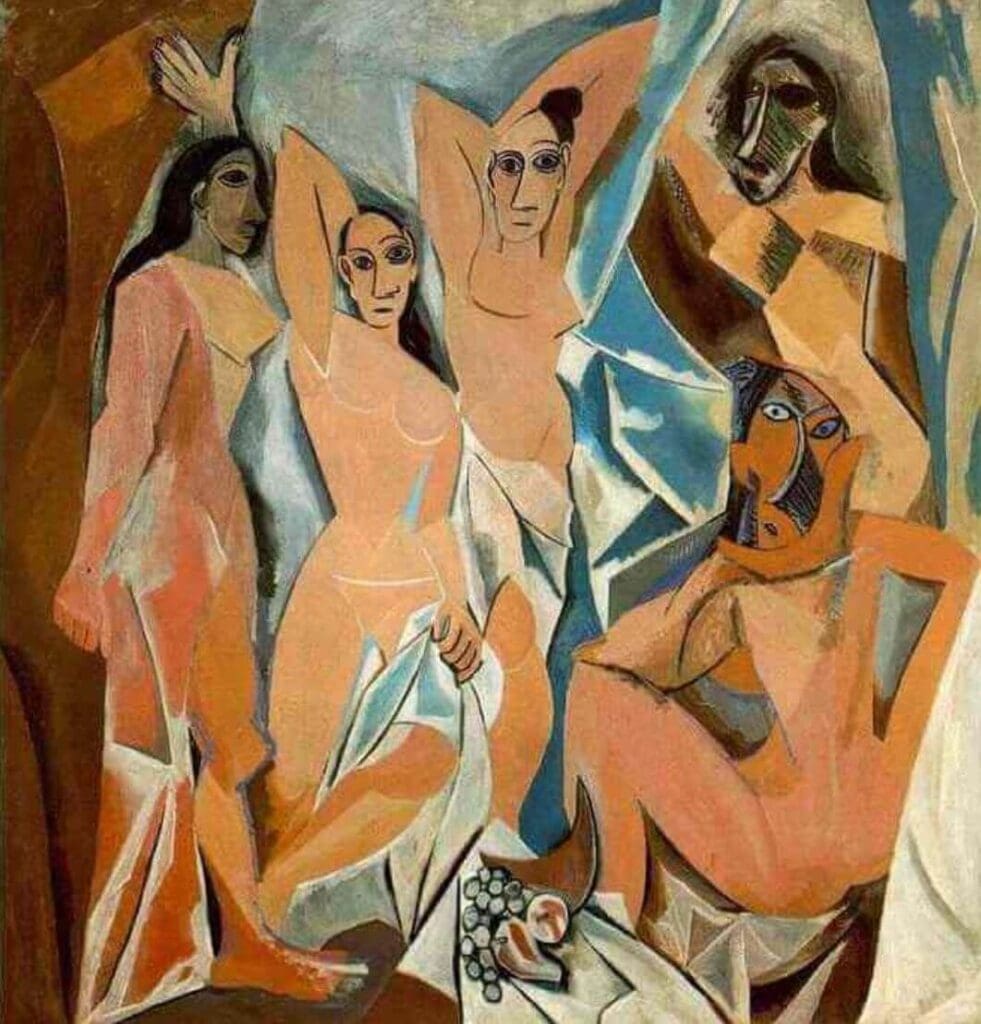Gifted with an unprecedented artistic vision and masterful technique, Pablo Picasso stands among the most significant influential figureheads in the panorama of 20th-century art. This prodigious personality introduced a revolutionary spectrum of styles and themes that shook the art world’s foundation at its core.
Born into a humble family in Malaga, Spain, Picasso’s artistic flair was nurtured under his father’s tutelage, propagation through the Royal Academy of Fine Arts, and a defining Blue Period sparked by personal tragedies.
Table of Contents
- Picasso’s Early Life and Inspiration
- Picasso’s Artistic Evolution and Styles
- Major Works and Their Impact on the Art World
- Picasso’s Legacy and Influence
- Related Questions
Picasso’s Early Life and Inspiration
Renowned for his transformative influence on 20th-century art, Pablo Picasso’s journey presents an intricate tapestry of personal evolution, cubist revolution, and unceasing creation.
Therefore, a deep delve into the early experiences and inspirations that shaped such a remarkable life offers insight and appreciation of how his meteoric journey began.

Born in Málaga, Spain, 1881, Picasso was immersed in the rich artistic culture of his birthplace. His father, a painter and art teacher, sparked his interest in art at a young age, offering him his first instructions in drawing and oil painting.
Recognition of the prodigious talent of the young Pablo Picasso led to his acceptance into the School of Fine Arts in Barcelona at the tender age of just 13 – an early indication of the artistic prowess that would later reverberate throughout the world.
Yet, his early traditional art education didn’t meet Picasso’s insatiable thirst for innovation or his innate ability to push boundaries. Gaining exposure to many influences, including El Greco, Edvard Munch, and African and Iberian sculptures, Picasso experimented and evolved artistically, breaking free from the shackles of classic form.

A key turning point came during the artist’s ‘Blue Period,’ reflecting personal hardship in hues of melancholy blue. Picasso navigated the bitter loss of a close friend, a period of poverty, and mental strain, painting his experiences to render raw emotion in heart-rending portraits of human suffering.
Out of these tribulations, Picasso affirmed that art was not only about beauty – it was a vehicle for expressing profound emotions and experiences, leaving an indelible imprint on his artistic voice.
These formative components contributed to his remarkable artistic evolution, from his early interactions with art through his father to his profound personal experiences.

The ‘Rose Period,’ his dalliance with the ‘African Art-inspired Period,’ and the genesis of Cubism attest to Picasso’s audacity in displacing convention and pioneering his trail in the art world.
Understanding how Picasso’s past shaped his journey offers a profound lesson in courage and ingenuity. Influences from traditional Spanish culture and other global art forms did not confine his innovations. Instead, these foundations formed the springboard for Picasso to challenge norms and revolutionize the depiction of form, space, and reality.
Inspired by his joyous and tragic experiences, Picasso resonated through his brush strokes and the shaping of clay. His unique perspective transformed his art and broader conception of art, encapsulating the human spirit in its diverse expressions.
If Picasso’s journey tells us one thing: art holds the power to change, evolve, and profoundly influence cultures and epochs. It’s the dialogue of the human experience, conducted through hands, onto canvas, and into our very souls. Therein lies the magic of art, the magic of Pablo Picasso.
Picasso’s Artistic Evolution and Styles
How Picasso Transformed the Art World
A luminary in his own time, Pablo Picasso is still one of the most transformative figures in art history. His fearlessness in challenging established norms amplified the evolution of art throughout the 20th century.
Although he is renowned as the co-founder of Cubism, his contributions stretch beyond one specific movement. The avant-garde trailblazer shaped various artistic movements through his stylistic evolution, thus paving the way for a true revolution in art.
Cubism: A Revolutionary Movement
In the early 20th-century Paris, Picasso and fellow artist Georges Braque unveiled Cubism, an entirely new approach to representing reality in art.
Provocatively defying the traditional one-point perspective, Cubism involved the simultaneous breakup of subjects into geometric forms, offering multiple viewpoints.

Considered his most innovative contribution, Cubism challenged the status quo. The dynamism of “Les Demoiselles d’Avignon,” perhaps the first Cubist painting, teems with fragmented forms, revealing Picasso’s unapologetic departure from realism. This unique style carries a sense of reality’s dynamic, ever-changing nature, as the modern sensitive consciousness perceives it.
Symbolism and Surrealism: The Fantastical World of Art
While Picasso never formally joined the Surrealist movement, he significantly impacted its progression.

His work embodied the overarching themes of Surrealism, such as dreams, violence, and the irrationality of the subconscious mind. “Guernica” depicts the nightmarish horrors of the Spanish Civil War in a surrealistic style, indicating Picasso’s alignment with the movement’s ideals.
Symbolism also found a place in Picasso’s eclectic style. During his “Rose Period,” elements like saltimbanques, circus performers, and clowns symbolized solitude and desolation, demonstrating his profound use of symbolism.
Classicism and Neoclassicism: A Return to Tradition

In the aftermath of World War I, Picasso diverged from Cubism and Surrealism, initiating a “Return to Order”— his phase of Classicism and Neoclassicism. Works like “Three Women at the Spring” indicate his turn to more traditional Greco-Roman aesthetics, with their focus on balanced proportions and serene compositions.

The turbulent times they provoked Picasso to seek solace in the familiar world of classical beauty, showing how the classic and the contemporary could harmoniously coexist in his oeuvre.
From the radical experiments in Cubism to the mystic symbolism and back to the tranquility of Classicism, Picasso’s stylistic journey delineates his transformative effect on multiple art movements.
Whether shattering the norms or embracing the traditional, his impact remains undeniable. Indeed, as his art constantly evolved, so did the art world’s attempts to keep up with this unfathomable genius.
Picasso’s lasting legacy stands as a testament to the transformative power of creativity and the irrepressible force of art in making sense of our ever-evolving world.
Major Works and Their Impact on the Art World
Pablo Picasso, an icon in art, revolutionized pictorial art and left a mark with his unique creations and style. His intricate visual language not only added depth to art history but also drastically transformed 20th-century art and continues influencing contemporary artists.
As we delve deeper into his significant works, one can appreciate the sheer brilliance and radical vision that Picasso bestowed upon the art scene.

Picasso’s most renowned work, ‘Les Demoiselles d’Avignon,’ marked a radical break from traditional European painting. It shattered the conventions of representation, demonstrating a new form of visual expression, which laid the foundations for Cubism.
The painting depicts five nude women in a brothel, straying from the polished final effect associated with most classical artworks. Instead, it captured the raw essence of the subject, introducing a new perspective in approaching art and depicting reality.
In tandem with Georges Braque, Picasso is celebrated as a co-founder of the Cubist movement. This revolutionary shift in artistic style came to life vividly in works like ‘The Three Musicians.’ This enormous canvas uses the potent techniques of Synthetic Cubism, employing collaged cut-out forms to create the image of three masked players.
Here, Picasso recreated the world not as it appears but as a structure of modulated forms and voids. Cubism challenged conventional representation, fragmented the form, and unraveled the diversity of perspectives. Thus, through Cubism, Picasso developed a new visual lexicon and dramatically influenced the path of abstract art.
One cannot mention Picasso’s work without highlighting the powerfully political ‘Guernica.’ This colossal mural-sized oil painting is his response to the bombing of Guernica, a town in his beloved Spain, during the Spanish Civil War.

Showcasing his astute use of symbolism and his move towards Surrealism, ‘Guernica’ was a radical protest against violence and the horrors of war, declaring Picasso’s deep involvement in political and social realism.

Even as Picasso heralded the modernism movements, he occasionally delved into classicism and neoclassicism. One such example is ‘The Pipes of Pan.’ His neoclassical period, post-World War I, is known to have celebrated tradition and order. Picasso’s stylistic versatility showcases his deep understanding of art and ability to enrich any movement he ventured into.
Picasso’s explicit changes in style and mode of representation throughout his career depict his explorative spirit and boundless creativity. Still, these evolutions also underline his immense impact on contemporary art.
Each of Picasso’s artistic periods is marked by undeniable originality and extraordinary innovation, forging an enduring legacy that continues to shape the art world. Picasso’s genius lies in bringing forth the complexities and ambiguities of the human condition, immortalizing them onto canvas, and shaping millions of perceptions and interpretations.
This impact shows the true power of art and Picasso’s central role in harnessing and demonstrating this power.
Picasso’s Legacy and Influence
Pablo Picasso, undoubtedly, has an enduring legacy that continues to profoundly influence not just the realm of art but every imaginative endeavor undertaken by humankind.
Among his mammoth body of visual artworks — numbering more than 20,000, the modernist master forged entirely new directions and art forms that are still being revisited, re-understood, and relished today.
Picasso’s animated involvement in manifold art movements across his seven-decade-long career, most famously co-founding the Cubist movement with Georges Braque, resonates through centuries.
One cannot possibly disregard the significance of the invention of ‘collage,’ a creative technique widely utilized in various contemporary areas, including fashion, graphic design, cinema, and interior design.
The famous work, ‘Les Demoiselles d’Avignon,’ widely seen as a cornerstone of 20th-century art, still manages to shock the viewer with its audacity. It disregards traditional European conventions, instigating a fresh perspective on the nature of both Madonna and Harlot.
Furthermore, the painting is a guiding beacon for many contemporary artists, inspiring them to transgress boundaries and normality.
Expanding upon the exciting development of Cubism, Picasso pursued the permutation of Synthetic Cubism, characterized by an increased complexity of image and color.
‘The Three Musicians’ represents a perfect exemplar of this style, featuring a fragmented compilation of shapes arranged to evoke an engaging narrative that transcends reality. This manipulation of reality through fragmented forms, textures, and colors resonates profoundly in contemporary art.
Picasso’s immortal masterpiece, ‘Guernica,’ displays art’s strength as a political tool and a protest against atrocities. Its symbolism, portraying the horrors of the Spanish Civil War, remains a poignant critique of conflict. It maintains relevance today, resonating with artists who persist in addressing political dialogues and societal issues through their work.
Moreover, in his later years, Picasso explored Classicism and Neoclassicism, as evidenced by ‘The Pipes of Pan.’ It shows how effortlessly he oscillated between styles and epochs, breaking predetermined notions about art. This flexible artistic dexterity and seamless transition across different styles is apparent in contemporary art.
Picasso’s remarkable range and versatility have left a noticeable impact on artists today, inspiring them to venture beyond the constraints of a singular style. Additionally, contemporary artists draw from Picasso’s artistry in capturing the complexities and ambiguities of the human condition.
His ability to convey multi-faceted layers of emotion, from joy to despair, nudges modern artists to explore in-depth narratives that echo the realities of human experiences.
Indeed, the magic of Picasso’s art is its undying power, even decades after his departure. His ceaseless creativity, audacity to challenge, and searing artistic vision framed his legacy and significantly shaped our global art landscape.
The spirit of Picasso undeniably lives on in every stroke an artist applies onto a canvas, boldly carving the art of tomorrow.
Pablo Picasso’s legacy remains a monumental testament to artistic evolution, as his creative audacity instilled a resonant vigor in forthcoming generations of artists.
Each period of Picasso’s artistic timeline reflects a mirror into a world rich with stylistic reinventions, audacious experimentations, and an unyielding resilience to societal norms.
His major works, like ‘Guernica’ and ‘Les Demoiselles d’Avignon,’ showcase a deep-seated commentary on the socio-cultural landscapes of his time, further solidifying Picasso’s status as a fearless innovator, unafraid to push the envelope of artistic conception.
Thus, Picasso’s indelible influence and legacy continue to reverberate in the corridors of the contemporary art world.
Anita Louise Art is dedicated to art education, great artists, and inspiring others to find and create their art. We love art that uplifts and inspires. #ArtToMakeYouSmile! #ArtToMakeYouHappy!
If you want to see any of my art, you can find out more by clicking here. If you are interested in what inspires me and my paintings, you can discover more by clicking here.
We have a free newsletter and would love you to be part of our community; you can subscribe to the newsletter by clicking here. If you have any questions, I would be happy to talk to you. You can reach me, Anita, by clicking here.
Subscribe to our Anita Louise Art YouTube Channel with great videos and information by clicking here.
Join us for our podcast “5 Minutes With Art.” Spend 5 minutes a week with us to discover and learn about great art and artists. You can find out more about our podcast by clicking here.
Related Questions
The Ten Most Famous Paintings: A Journey In Artistic Triumphs
We have gone through the list of all the important paintings and listed what we see as the 10 most important ones. Many on this list are very famous as the Mona Lisa. Others include one of my favorite American paintings of the American Gothic. Read on as we explore what we see as ten of these most essential paintings ever created.
By clicking here, you can learn more by reading The Ten Most Famous Paintings: A Journey In Artistic Triumphs.
Why Is The Chinese Artist Ai Wei Wei So Famous? 7 Reasons Why
Ai Wei Wei is a highly captivating artist who produces amazing art installations. His art speaks of political activism as he places himself in the middle of world events. He uses Chinese art forms in his art, along with photography and video.
By clicking here, you can learn more by reading Why Is The Chinese Artist Ai Wei Wei So Famous? 7 Reasons Why.
21 Top Renaissance Artists And Their Works Of Art
When we speak of top Renaissance artists, we think of the trinity of artists like Leonardo da Vinci, Michelangelo, and Raphael. But besides these three artists, many other influential Renaissance artists remain essential.
By clicking here, you can learn more by reading 21 Top Renaissance Artists And Their Works of Art.


